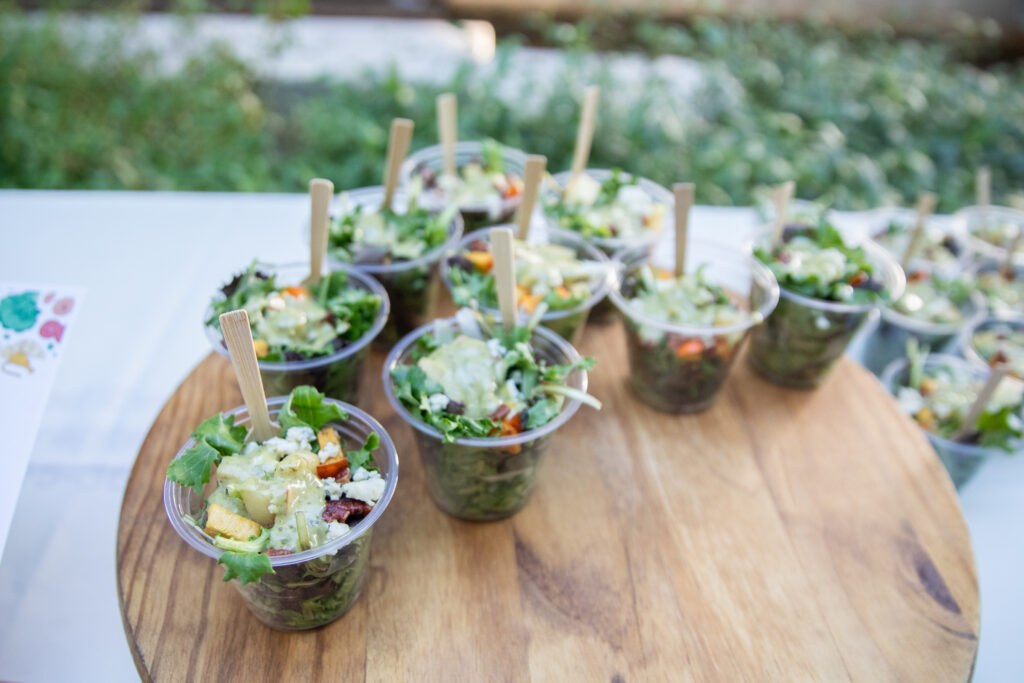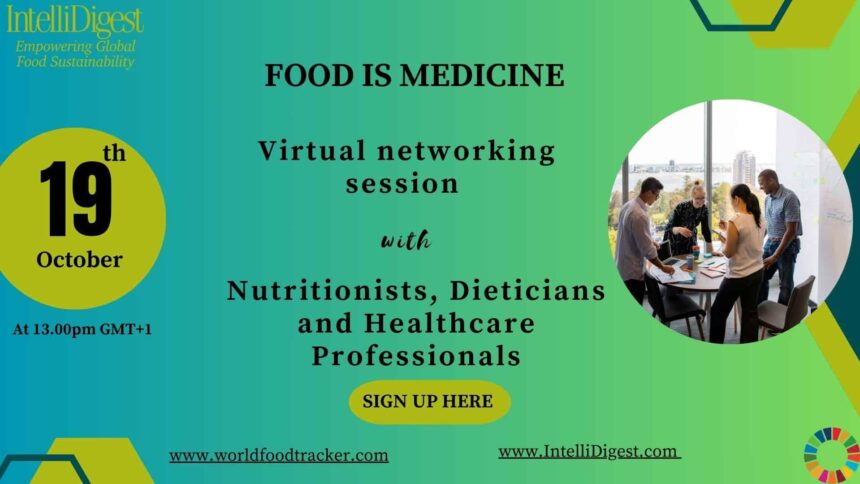Food Is Medicine: The “Food Is Medicine and Eating for Health” event at Arizona State University (ASU) on World Food Day 2025 brought together thought leaders, innovators, chefs, and community advocates to explore how food can drive health and sustainability. Tom Pesek, senior liaison officer of the U.N. Food and Agriculture Organization, opened the event with staggering statistics: 673 million people go to bed hungry each night, and 2.6 billion cannot afford a nutritious diet—nearly one-third of humanity. These numbers underscored the urgency of rethinking how we produce, consume, and access food globally.
Cohosted by ASU’s Swette Center for Sustainable Food Systems, Food Tank, the Food and Agriculture Organization, and the Sprouts Healthy Communities Foundation, the event emphasized collaborative solutions. Trailblazers from science, agriculture, health, culture, and community advocacy convened at the Walton Center for Planetary Health in Tempe to share strategies for improving food production, accessibility, and sustainability. Through breakout sessions led by ASU faculty and graduate students, attendees brainstormed actionable ideas to advance science, policy, and community initiatives in nutrition and food security.
The event also highlighted culinary innovation as a vehicle for health. Attendees sampled dishes prepared by acclaimed chefs using ingredients supplied by Sprouts Farmers Market and Duncan Family Farms. Kathleen Merrigan, executive director of ASU’s Swette Center, emphasized the importance of community engagement: “I want people to get excited about the idea of healthy food and to hear new and interesting ideas they haven’t heard before. We need our community in Maricopa County and Arizona working together on these issues more often.”
Embracing Ancestral Intelligence in Food Systems
While the concept of “food as medicine” has gained popularity, its principles are rooted in centuries of Indigenous knowledge. Many Indigenous communities have long practiced regenerative agriculture and prioritized diet for health.
Debra Utacia Krol, Indigenous affairs reporter and Xolon Salinan Tribe member, highlighted the resilience of traditional practices: “In California, we’ve had at least three 100-year-long droughts in the last 5,000 years. If anyone knows how to adapt to drought, it’s us.” Krol, alongside Denisa Livingston of the Diné Community Advocacy Alliance, stressed the importance of preserving traditional food systems, educating younger generations, and protecting the right to save and sell indigenous seeds. Livingston reframed AI as “ancestral intelligence,” urging attendees to view themselves as ancestors responsible for future generations.
Reviving Heritage Crops: The Case of Fonio
James Beard Hall of Fame chef Pierre Thiam shared his journey of bringing fonio, a highly nutritious, drought-resistant grain native to West Africa, to U.S. markets through Yolélé Foods. Growing up in Senegal, Thiam enjoyed fonio but struggled to find it as a chef in New York. Instead of substituting ingredients, he worked to bring fonio to the U.S., creating aggregation centers run by farmers to ensure equitable economic opportunities.
Fonio not only preserves cultural heritage but also supports sustainable agriculture. Its deep roots prevent soil erosion, and it thrives in poor soils, promoting environmental resilience. Thiam emphasized that “food as medicine” should not be a passing trend, but a return to diverse diets and sustainable consumption practices.Cultivating Sustainable Food ProductionFonio not only preserves cultural heritage but also supports sustainable agriculture. Its deep roots prevent soil erosion, and it thrives in poor soils, promoting environmental resilience. Thiam emphasized that “food as medicine” should not be a passing trend, but a return to diverse diets and sustainable consumption practices.
Read about: WHN Joins in the Chorus: Medical Masks Are Not PPE
Cultivating Sustainable Food Production
Sustainable agriculture was a central theme, with insights from leaders like Brandon Lombardi, chief sustainability officer at Sprouts. He noted that 60% of Sprouts’ produce and 30% of all products are organic. To support farmers transitioning to organic farming, Sprouts offers multi-year contracts, reducing financial risk and promoting environmentally friendly practices.
Arnott Duncan, owner of Duncan Family Farms, shared how composting and organic methods transformed his family’s operations across Arizona, Oregon, and New York. “Composting became the way for us to farm. Now we’re 100% organic,” he said, demonstrating that sustainable farming can produce high-quality, nutritious food while supporting environmental stewardship.

From Farms to Families: Linking Food and Health
James Beard Award-winning chef Michel Nischan highlighted the direct link between fresh, nutritious food and long-term health. With Wholesome Wave, he created programs like the Double Value Coupon Program, doubling SNAP benefits for fruits and vegetables, and the National Produce Prescription Collaborative, which encourages coverage for healthy food under government health plans.
Despite these efforts, challenges remain. Crystal FitzSimons, president of the Food Research & Action Center, noted that millions of Americans face cuts to programs like SNAP, impacting children, seniors, and vulnerable populations. She emphasized that good nutrition not only promotes health but also reduces $160 billion annually in direct and indirect healthcare costs associated with hunger and food insecurity.
Measuring Food as Medicine
Defining “healthy food” remains complex. Selena Ahmed of the American Heart Association highlighted the Periodic Table of Food Initiative, which aims to quantify the nutritional and medicinal properties of foods beyond traditional nutrient metrics. “We still measure nutrition on a handful of nutrients, the same as in the 1950s. Food is far more complex,” Ahmed explained, advocating for modern, science-driven tools to guide dietary choices.
Conclusion
The “Food Is Medicine” event at ASU 2025 showcased a convergence of science, culture, and community action toward sustainable, health-focused food systems. By embracing ancestral knowledge, reviving heritage crops, and fostering organic, sustainable agriculture, participants highlighted the multiple benefits of linking food production to human health and environmental stewardship.
Programs like Wholesome Wave’s produce prescriptions and SNAP enhancements demonstrate the social impact of integrating nutrition with public health strategies. These initiatives ensure that healthy, nutrient-rich foods reach those who need them most, promoting equity and long-term wellbeing.
The event also emphasized the importance of policy support and innovative research to scale up successful interventions. From measuring the nutritional complexity of foods to creating sustainable market systems for farmers, the solutions presented serve as models for communities worldwide.
Ultimately, “food as medicine” is more than a trend—it is a call to action. Reconnecting diets with health, biodiversity, and cultural heritage has the potential to transform individual lives and society at large, ensuring that future generations inherit both the knowledge and the means to thrive.
Also read: New Gold? Why Wealthy Families Are Investing in Countries, Not Just Stocks
FAQs: Food as Medicine and Sustainable Health
1. What is the concept of ‘food as medicine’?
“Food as medicine” emphasizes the idea that nutritious, whole foods can prevent, manage, or even treat health conditions. By prioritizing diets rich in fruits, vegetables, whole grains, and culturally significant foods, communities can reduce the risk of chronic diseases like diabetes, heart disease, and obesity. The approach integrates nutrition with healthcare and public policy.
2. How can ancestral knowledge contribute to modern food systems?
Indigenous and traditional agricultural practices, such as regenerative farming and seed preservation, offer valuable insights into sustainable food production. These methods enhance soil health, conserve water, and promote biodiversity. Incorporating ancestral knowledge helps communities adapt to climate change, improve nutrition, and protect cultural heritage.
3. What role do heritage crops like fonio play in sustainability?
Heritage crops are often drought-resistant, nutrient-dense, and adapted to local ecosystems. Fonio, for example, grows in poor soils, prevents erosion, and provides economic opportunities for farmers. Supporting such crops promotes biodiversity, environmental resilience, and healthier diets.
4. How do programs like Wholesome Wave link food to health?
Wholesome Wave connects fresh produce to low-income communities through initiatives like the Double Value Coupon Program and the National Produce Prescription Collaborative. These programs increase access to nutrient-rich foods, incentivize healthy eating, and reduce healthcare costs associated with poor nutrition.
5. What challenges remain in implementing food-as-medicine initiatives?
Barriers include limited access to nutritious foods, funding cuts to programs like SNAP, and lack of standardized tools to measure the health impact of food. Additionally, scaling sustainable agriculture and maintaining economic viability for farmers are ongoing challenges. Policy support, community engagement, and research are essential for overcoming these hurdles.
